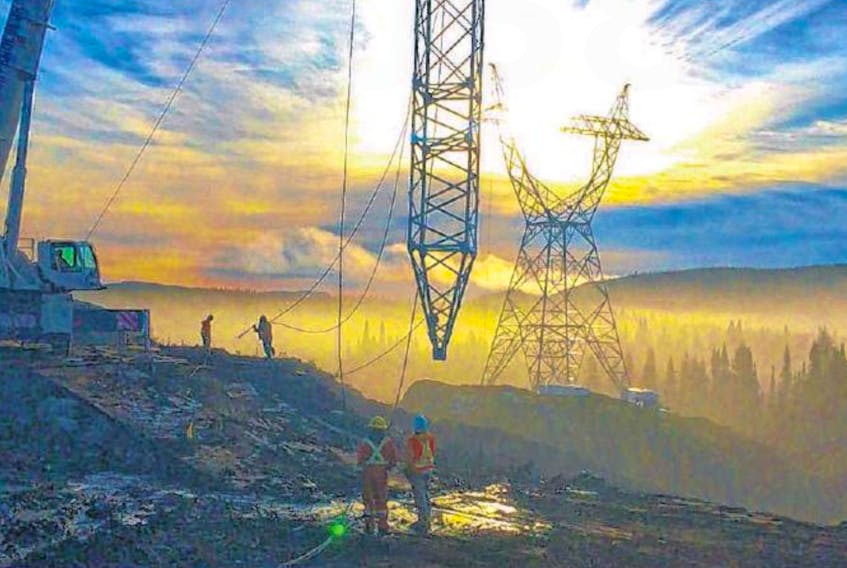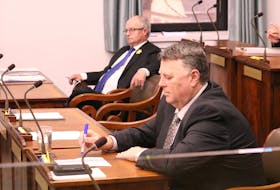So, I heard from a reader in Sweden.
Had I heard about the SydVastlanken, he wondered?

I hadn’t.
Well, much like the Labrador Island Link, the SydVastlanken (or South West Link) is a high voltage direct current (HVDC) power line system.
The project was started in 2011 and included connecting the Swedish towns of Hallsberg and Barkeryd with 250 kilometres of HVDC cables and overhead lines. The project was supposed to help even out Swedish electrical prices and was to cost $1.07 billion. It was a turnkey project, including valve modules, transformers and “control systems from the HVDC excellence centre in Stafford, U.K.,” according to the successful bidder, General Electric Grid Solutions.
GE Grid Solutions is also the successful bidder on the Labrador Island Link.
The LIL bid was also a “full turnkey project,” according to GE, and also includes valves, transformers and control systems — control systems that are also coming from the company’s Stafford, U.K. site.
The LIL was supposed to come into service last summer — then, at the end of October. Then it was supposed to be operation for January.
There are lingering problems with the software that operates the control system. The line is currently using Version 15 of the software — Version 16a has arrived but hasn’t been installed: “The decision was based on the limited benefit of the additional features of Version 16a and the risk to the schedule of implementing a new version which would have to undergo additional testing,” according to Newfoundland and Labrador Hydro documents.
The LIL was supposed to come into service last summer — then , at the end of October. Then it was supposed to be operation for January.
An external consultant reviewing that decision noted: “Recommendation by external HVDC consultant has been documented, findings include that there is a minimal benefit associated with version 16a, with no assurance that installation can be achieved in the ongoing planned outage without a negative impact. Based upon these findings it is not recommended to install the software …”
So, part of the system will be operated manually through the crucial winter season, when we may need the power.
Turns out the SydVastlanken’s software isn’t doing so well either.
The SydVastlanken was supposed to have been brought online in 2015.
Now, the Swedish utility, Svenska Kraftnat, is hoping the line may come into full service by March 2019 — four years late.
Here’s part of an email from Svenska Kraftnat communications officer Joel Nylin.
“(It) occurs as our problems are similar with yours. GE Grid haven’t been able to deliver the technical solutions in converter stations. All other parts of the project such as the physical elements have been finished according to plan. The four-year delay of the HVDC-link are due to that GE Grid haven’t been able to make the system function in a stable and satisfying way,” Nylin writes.
“There isn’t a specific issue delaying the commission but a number of faults and deviations that are being handling in order to get all parts of the functions to work and communicate as intended. For instance, there have been numerous deviations in the control and protections systems.
“The problems have variated all from quality flaws to need for developing new software solutions. The remaining work consists of testing, handling deviances and implementing solutions. There is continuous progress in the work and even though the link has been postponed several times, we are still optimistic that GE Grid will be able to finish the job.”
Clear, forthright, frank and delivered in a few hours. By comparison, Nalcor’s response when I started asking them about their issues with GE software months ago? “As we move through the commissioning phase of the LIL, GE is continuing to develop its software as this is the normal course of software development for these type of transmission projects.”
Newfoundland Hydro has since warned the province’s Public Utilities Board about the software problems, saying, “Hydro acknowledges that the reliability of the current GE software implementation has yet to be demonstrated and remains a risk to the reliable in-service of the LIL.”
Liberty Consultants, working for the PUB, have been warning about GE’s performance for months now, pointing out, “It bears note that General Electric corporate-wide has experienced significant legal problems and financial turmoil, with concern particularly focused on its power business. GE’s power unit plans to cut over 15 per cent of its work force this year.”
GE’s troubles, Liberty said, “presents major challenges for a project whose performance has lagged and continues to do so.”
So there are delays and concerns aplenty.
Why does it matter? Because we might critically need the power as soon as this winter.
And every delay means interest payments continue to pile up on themselves.
But it’s not the SydVastlanken. At least not yet.
Recent columns by this author
RUSSELL WANGERSKY: Clear as mud
RUSSELL WANGERSKY: Setting the stage for #DarkNL 2
Russell Wangersky’s column appears in 36 SaltWire newspapers and websites in Atlantic Canada. He can be reached at [email protected] — Twitter: @wangersky.









